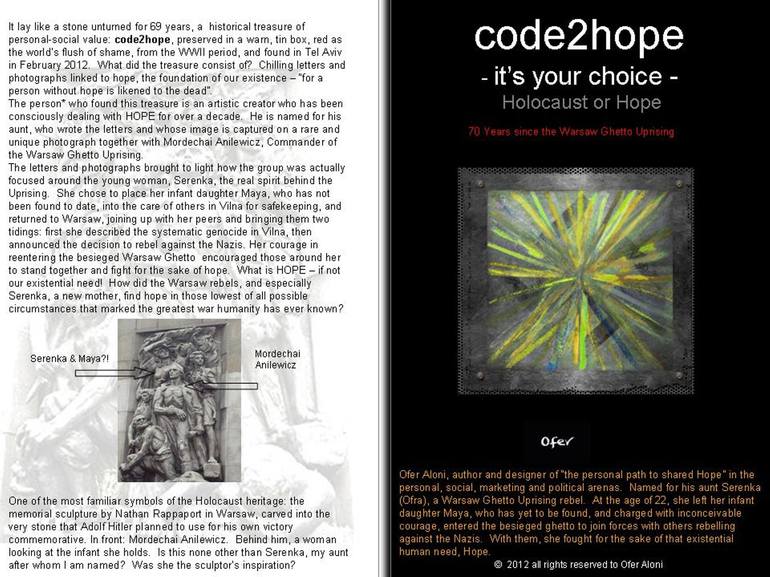





VIEW IN MY ROOM
code2hope - Book cover Print
Israel
Select a Material
Canvas
Select a Size
16 x 12 in ($136)
Select a Canvas Wrap
Black Canvas
Add a Frame
White ($135)
About The Artwork
The mental ghetto is worse than the physical ghetto. That’s because you are not conscious of the mental ghetto. As for the physical ghetto, you are keenly aware of hunger and can choose to rebel against it. Is someone leading us “like sheep to the slaughter” concerning matters related to the Holocaust in general, and the Warsaw Ghetto Uprising in particular? “Dependency on Yad Vashem is problematic”, says Professor Daniel Blatman in his critical remarks on the “Haaretz” newspaper of 19 April 2013. Questions surfacing as a result of Ofer’s trip to search for Maya, daughter of Sarenka, the Warsaw Ghetto Uprising rbel 1. The scandal. Why has the story of the 50 Warsaw Ghetto rebels, whose names are engraved on a small headstone in Warsaw, been censored until now? Are you familiar with any name other than Mordechai Anilewicz? 2. Censorship. Who censored the journalists, including foreign journalists from the “New York Times”, vis a vis Sarenka’s story, especially since its publication could help find her daughter Maya? 3. The absurdity. How can it be that Sarenka appears in the photograph – almost the only one existing in the world showing Mordechai Anilewicz – but she herself is censored even though the photo was given to museums by Ofer Aloni’s mother (who owns the original)? 4. Are there still Kapos in the world? Who was the informant to the Polish Police Force prior to Ofer’s visit there to attend the ceremony commemorating 70 years since the Warsaw Ghetto Uprising, and caused him to be arrested as he stood near the Warsaw Ghetto Uprising commemorative sculpture? (Take note that the sculptor himself, Nathan Rappaport, also received the photograph in clause 3 above from Ofer’s mother). 5. Is there democracy? Why was Ofer thrown out of Yad Vashem by its security guards, when he asked a democratic question of Dr Dreyfus, who is “responsible for memorializing the Holocaust”? The question Ofer asked was: “Why do you censor the 50 fighters whose names are engraved on the memorial at Mila 18, the command bunker of the Warsaw Ghetto Uprising?” 6. Does the history of the Warsaw Ghetto Uprising belong to a particular person? Is someone trying to control the memorialization of the Holocaust? What may that person or persons interests be in denying a simple truth – as testified to by Aliza Vitis-Shomron, and tens of documents discovered in February 2012 in Tel Aviv? 7. Was George Orwell right? He said: “Who controls the present, controls the past.” Is Bob Dylan right? “History is a funny thing. It can change. Events which we believed occurred maybe never did, and vice versa.” 8. Mordechai Anilewicz was known for his concept of “Don’t accept it.” Is this concept, used as a money-maker, denied by the Holocaust institutions themselves? How can it be that Holocaust institutions operate in direct contravention of Mordechai Anilewicz’s own directives? “Let us not forget that the most difficult of wars is that within ourselves: Not to accustom ourselves and adapt to these conditions! For one who adapts (even to a high-level role – O.A.) ceases to discern between good and evil, and becomes a servant to body and mind. No matter what should happen to you, remember, always: do not accustom yourselves. Do not adapt yourselves. Rebel against this reality.” 9. Is the historian not meant to behave like the archeologist? If a shard of clay can offer new relevance to our history, how can testimony, books, letters and photographs not be relevant? 10. Is someone leading us “like sheep to the slaughter” concerning matters related to the Holocaust in general, and the Warsaw Ghetto Uprising in particular? “Dependency on Yad Vashem is problematic”, says Professor Daniel Blatman in his critical remarks on the “Haaretz” newspaper of 19 April 2013.
Details & Dimensions
Print:Giclee on Canvas
Size:16 W x 12 H x 1.25 D in
Size with Frame:17.75 W x 13.75 H x 1.25 D in
Frame:White
Canvas Wrap:Black Canvas
Ready to Hang:Yes
Packaging:Ships in a Box
Shipping & Returns
Delivery Time:Typically 5-7 business days for domestic shipments, 10-14 business days for international shipments.
Handling:Ships in a box. Art prints are packaged and shipped by our printing partner.
Ships From:Printing facility in California.
Have additional questions?
Please visit our help section or contact us.
Ofer Sarenka Aloni, author and designer of “the personal path to shared Hope” in the personal, social, marketing and political arenas. Named for his aunt Sarenka (Ofra), a Warsaw Ghetto Uprising rebel. At the age of 22, she left her infant daughter Maya, who has yet to be found, and charged with inconceivable courage, reentered the besieged ghetto to join forces with others rebelling against the Nazis. With them, she fought for the sake of that existential human need, Hope.
Thousands Of Five-Star Reviews
We deliver world-class customer service to all of our art buyers.
Global Selection
Explore an unparalleled artwork selection by artists from around the world.
Satisfaction Guaranteed
Our 14-day satisfaction guarantee allows you to buy with confidence.
Support An Artist With Every Purchase
We pay our artists more on every sale than other galleries.
Need More Help?